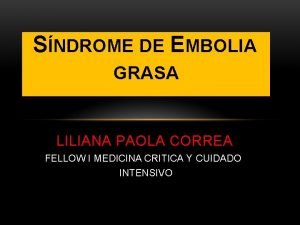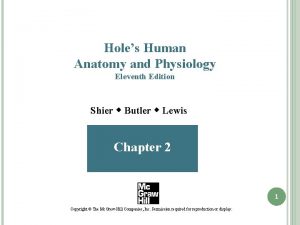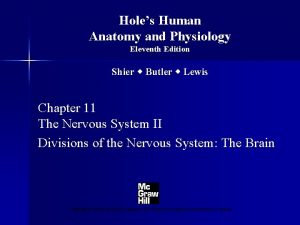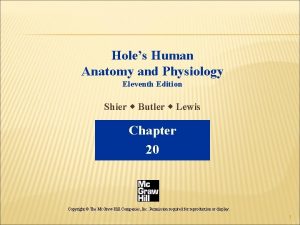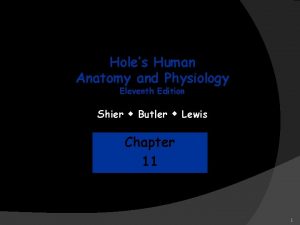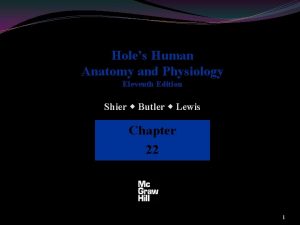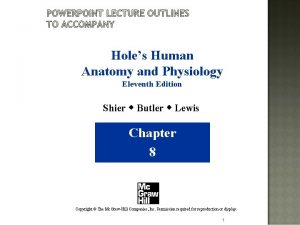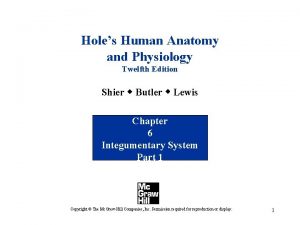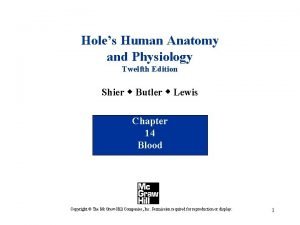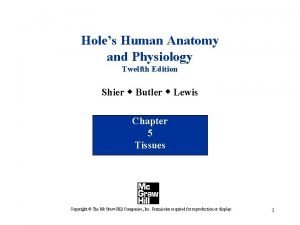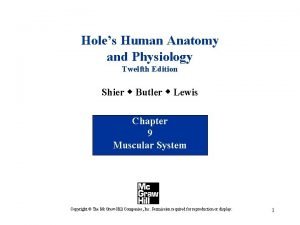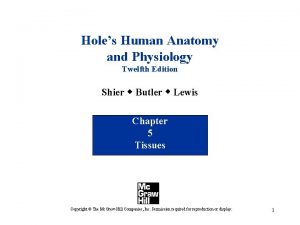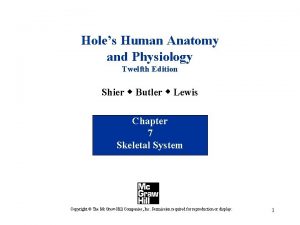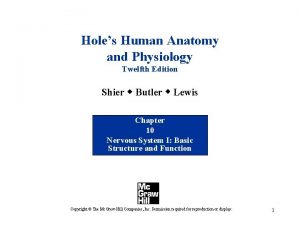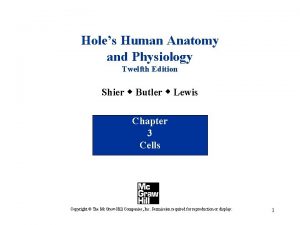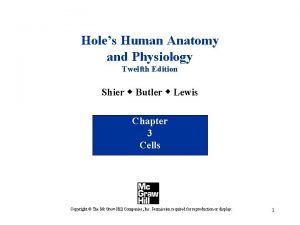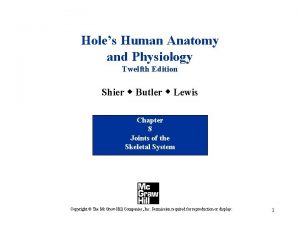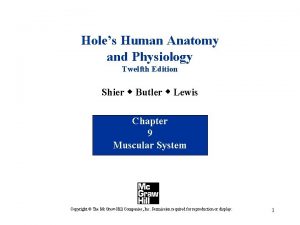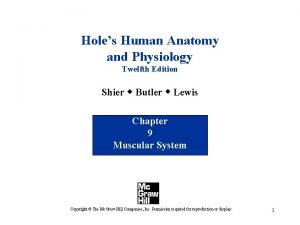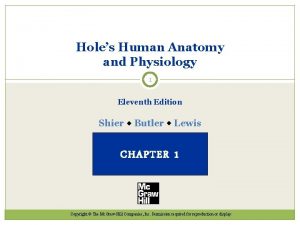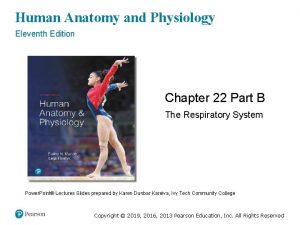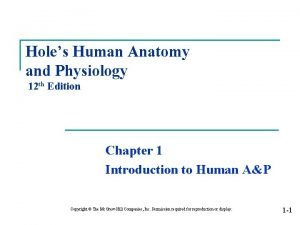Holes Human Anatomy and Physiology Eleventh Edition Shier



























- Slides: 27

Hole’s Human Anatomy and Physiology Eleventh Edition Shier w Butler w Lewis Chapter 3 Copyright © The Mc. Graw-Hill Companies, Inc. Permission required for reproduction or display. 1

Chapter 3: Cells Human body cells: • 70 trillion cells • 260 different types • eukaryotic • vary in size • possess distinctive shapes to fit their function • measured in micrometers 2

Cell Structure 3 major cell parts • nucleus • cytoplasm • cell membrane 3

Cell Membrane • outer limit of cell • controls what moves in and out of cell • selectively permeable 4

Cell Membrane Composed maily of: 1. phospholipid bilayer • water-soluble “heads” form surfaces • water-insoluble “tails” form interior • permeable to lipid (nonpolar)-soluble substances 2. proteins • receptors • self-markers • transport 5

Cytoplasmic Organelles Endoplasmic Reticulum • connected, membranebound sacs, canals, and vesicles • transport system • rough ER • studded with ribosomes • protein synthesis • smooth ER • lipid synthesis • break down of drugs Ribosomes • free floating or connected to ER • provide structural support 6

Cytoplasmic Organelles Mitochondria • membranous sacs with inner partitions • generate energy Golgi apparatus • stack of flattened, membranous sacs • modifies, packages and delivers proteins Vesicles • membranous sacs • store substances 7

Cytoplasmic Organelles Lysosomes • enzyme-containing sacs • digest worn out cell parts or unwanted substances Peroxisomes • enzyme-containing sacs • break down organic molecules Centrosome • two rod-like centrioles • distributes chromosomes during cell division 8

Cytoplasmic Organelles Cilia • short hair-like projections • propel substances on cell surface Flagellum • long tail-like projection • provides motility to sperm 9

Cytoplasmic Organelles Microfilaments and microtubules • thin rods and tubules • support cytoplasm • allows for movement of organelles 10

Cell Nucleus • control center of cell • nuclear envelope • porous double membrane • separates nucleoplasm from cytoplasm • nucleolus • dense collection of RNA and proteins • site of ribosome production • chromatin • fibers of DNA and proteins • stores information for synthesis of proteins 11

Movements Into and Out of the Cell Passive Transport • require no cellular energy • simple diffusion • facilitated diffusion • osmosis • filtration Active Transport • require cellular energy • endocytosis • exocytosis 12

Simple Diffusion • movement of substances from regions of higher concentration to regions of lower concentration • oxygen, carbon dioxide and lipid-soluble substances 13

Facilitated Diffusion • diffusion across a membrane with the help of a channel or carrier molecule • glucose and amino acids 14

Osmosis • movement of water through a selectively permeable membrane from regions of higher concentration to regions of lower concentration • water moves toward a higher concentration of solutes 15

Osmosis Comparing the outside environment to the inside of the cell • if both environments are of the same concentration of solute they are considered isotonic and will remain stable • if the outside solution has a higher solute concentration than it is hypertonic and the cell will shrink • if the outside solution has a lower solute concentration than it is hypotonic and the cell will swell 16

Active Transport • carrier proteins transport substances across a membrane from regions of lower concentration to regions of higher concentration • sugars, amino acids, sodium ions, potassium ions, etc. 17

Endocytosis • cell engulfs a substance by forming a vesicle around the substance • three types • pinocytosis – substance is mostly water • phagocytosis – substance is a solid • receptor-mediated endocytosis – requires the substance to bind to a membrane-bound receptor 18

Exocytosis • reverse of endocytosis • substances in a vesicle fuse with cell membrane • contents released outside the cell • EX: release of neurotransmitters from nerve cells 19

The Cell Cycle • series of changes a cell undergoes from the time it forms until the time it divides • 3 stages • interphase • mitosis • cytoplasmic division 20

Interphase • very active period • 2 phases • G phases – cell grows and synthesizes new organelles to prepare for cytoplasmic division • S phase – cell replicates DNA to prepare for nuclear division 21

Mitosis • produces two daughter cells from an original somatic cell • nucleus divides – karyokinesis • cytoplasm divides – cytokinesis • stages (PMAT) • prophase – chromosomes form; nuclear envelope disappears • metaphase – chromosomes align midway between centrioles • anaphase – chromosomes separate and move to centrioles • telophase – chromatin forms; nuclear envelope forms 22

Mitosis 23

Tumors Two types of tumors • benign – usually remains localized • malignant – invasive and can metastasize; cancerous Two major types of genes cause cancer • oncogenes – activate other genes that increase cell division • tumor suppressor genes – normally regulate mitosis; if inactivated they are unable to regulate mitosis • cells are now known as “immortal” 24

Stem and Progenitor Cells Stem cell • can divide to form two new stem cells • self-renewal • can divide to form a stem cell and a progenitor cell • totipotent – can give rise to every cell type • pluripotent – can give rise to a restricted number of cell types Progenitor cell • committed cell • can divide to become any of a restricted number of cells • pluripotent 25

Stem and Progenitor Cells 26

Clinical Application Diseases at the Organelle Level MELAS – mitochondrial encephalomyopathy, lactic acidosis, and stroke-like episodes • mitochondria are missing a gene necessary to carry out important energy producing reactions • usually inherited by mother • causes strokes, severe headaches, muscle weakness and numb hands ALD – adrenoleukodystrophy • peroxisomes are missing enzymes • causes dizziness, weakness, darkening skin, and abnormal heart rhythms Tay-Sachs Disease • lysosomes are abnormally large and lack one enzyme • causes nervous system failure and early death 27
 Holes essential of human anatomy and physiology
Holes essential of human anatomy and physiology Endomysium
Endomysium Human anatomy and physiology 10th edition
Human anatomy and physiology 10th edition Holes anatomy and physiology chapter 1
Holes anatomy and physiology chapter 1 Human anatomy & physiology edition 9
Human anatomy & physiology edition 9 Management eleventh edition
Management eleventh edition Management eleventh edition
Management eleventh edition Management eleventh edition
Management eleventh edition Management eleventh edition
Management eleventh edition Waistline
Waistline Anterior posterior distal proximal
Anterior posterior distal proximal Chapter 2 human reproductive anatomy and physiology
Chapter 2 human reproductive anatomy and physiology Api testing
Api testing Escala de shier
Escala de shier Shy степени сравнения
Shy степени сравнения Human anatomy fifth edition
Human anatomy fifth edition Human anatomy fifth edition
Human anatomy fifth edition Physiology of sport and exercise 5th edition
Physiology of sport and exercise 5th edition Eleventh 5 year plan
Eleventh 5 year plan Eleventh 5 year plan
Eleventh 5 year plan Thfive
Thfive For his eleventh birthday elvis presley
For his eleventh birthday elvis presley Upper respiratory system labeled
Upper respiratory system labeled Tattoo anatomy and physiology
Tattoo anatomy and physiology Science olympiad anatomy and physiology
Science olympiad anatomy and physiology Incomplete flower
Incomplete flower Anatomy and physiology bone
Anatomy and physiology bone Stomach ulcer
Stomach ulcer













